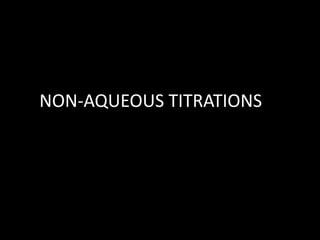Non-aqueous titrations are essential for analyzing complex organic medicinal compounds that exhibit poor solubility or weak reactivity in aqueous media, allowing for the titration of weak acids and bases in organic solvents. The document discusses various non-aqueous solvents categorized into groups based on their properties and the process of preparing and standardizing titrants like perchloric acid for effective titration. It also details specific titration examples for weak bases and weakly acidic substances, emphasizing the importance of solvent selection and standardized procedures for accurate results.


















































